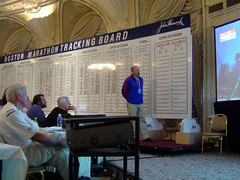Lotus Notes is a truly great software product. It is slicker than black ice in New England in January. It may not be the best thing since sliced bread, but is better than anything invented
before sliced bread. Alright, I may be over compensating to counter the claims at
Lotus Notes Sucks (and elsewhere), but I really do love Notes.

In the interests of full disclosure, I worked on Notes from 1996 through 2002. As a software developer, I contributed to versions 4.5, 4.6, 5.0 and 6.0. Obviously, I don't like to hear people bash the product I worked on. On the other hand, I have also
used Lotus Notes every working day for almost ten years. It is not and never will be a perfect product, but it also isn't nearly as bad as some people make it out to be.
Let's look at some indisputable facts:
- When it was introduced in 1989, Notes pioneered the concept of groupware.
- It is one the most successful desktop applications ever. For example, in 2000, Network Computing named Notes one of the top ten products of the 1990s.
- Unlike many products of its vintage, Notes is still going strong. According to Ed Brill, Notes still has 120 million seats (see comment #9). Microsoft in particular has repeatedly tried to kill Notes, and Microsoft has a history of obliterating the competition in many market segments (think Wordperfect, Lotus 123 and Netscape Navigator). How many products have been able to withstand sustained competition from Microsoft? Notes and Quicken are the only two products that come to mind.
So why do many people dislike Notes? Why does the anonymous owner of
Lotus Notes Sucks spend hours on his web site? Why does Jeff Atwood of Coding Horror fame
rant against Notes on his other blog? Are evil CIOs intentionally torturing their users with a defective product? That would be ironic considering the early adoption of Notes was
viral**.
In my opinion, people dislike Notes because their expectations don't jive with the original intent of the product. At its core, Notes is a runtime environment for collaborative applications, but when people complain about Notes, they are usually not talking about
core Notes at all. They are talking about the Notes Mail and Calendar applications.
Why does this distinction matter? It matters because the Notes core is what a lot of people really love. The three core features I really like are:
- Replication. This is what lets you disconnect from the network and continue to read and send mail. It's also what lets Domino servers maintain multiple copies of your mail file. I don't think any product does replication as well as Notes and Domino.
- Security. Notes security was way ahead of it's time in 1989. It is still rock solid.
- Programmability. You don't like the way Notes Mail works? Programmability lets you (or an IT developer) fix small problems and add completely new features in mail. It's also what lets you build entirely new applications for your business.
None of this means IBM should disregard people's complaints about Notes Mail and Calendar. Far from it. I know IBM takes these complaints very seriously. The Mail and Calendar applications have consistently improved from one release to the next. As a relatively new Notes 7 user, I am very impressed with the new features and quality of Mail and Calendar.
Here's what I am really saying to people who dislike Notes:
Grow up please. You may have preferred the mail application you used in your last job. You may have a dozen small complaints about how Notes works. But don't say Notes sucks and recommend throwing it out. That's like throwing out the baby with the bath water. Chances are your IT department has many good reasons for sticking with Notes. Have you asked what those reasons are?
** I mean viral in a good way. In the early days, small groups in large companies used Notes to solve real business problems they couldn't otherwise tackle. At first, this drove central IT departments crazy. Eventually, the IT departments understood the business justification and adopted Notes themselves.



 This past weekend, my thirteen-year-old son and I completed the New Hampshire Fish and Game Department's
This past weekend, my thirteen-year-old son and I completed the New Hampshire Fish and Game Department's 










 April 18 will be the 100th anniversary of the great San Francisco earthquake. The magnitude 7.8 earthquake devastated the city. The ensuing fire caused even more destruction.
April 18 will be the 100th anniversary of the great San Francisco earthquake. The magnitude 7.8 earthquake devastated the city. The ensuing fire caused even more destruction. 



 I think
I think 

 February has been a busy month for Google. If you use Gmail, you know they have integrated mail with
February has been a busy month for Google. If you use Gmail, you know they have integrated mail with  More recently Google announced a beta test of
More recently Google announced a beta test of  The hot, dry, dusty bush country of Botswana could hardly be further from New England in winter. Precious Ramotswe's job solving crimes and other mysteries could hardly be more different than working in an office. Maybe that's why I enjoyed
The hot, dry, dusty bush country of Botswana could hardly be further from New England in winter. Precious Ramotswe's job solving crimes and other mysteries could hardly be more different than working in an office. Maybe that's why I enjoyed 
 Charles Arthur and the Notes defenders, including me, remain very far apart on this issue. Mr. Arthur apparently lives in a parallel universe where the last three major releases of Notes never happened and where a vocal minority of Notes haters speak for the entire user population. He is, of course, entitled to his opinion, but the Notes supporters are conceding none of his points.
Charles Arthur and the Notes defenders, including me, remain very far apart on this issue. Mr. Arthur apparently lives in a parallel universe where the last three major releases of Notes never happened and where a vocal minority of Notes haters speak for the entire user population. He is, of course, entitled to his opinion, but the Notes supporters are conceding none of his points.
 A couple of nights ago NHPR's The Front Porch
A couple of nights ago NHPR's The Front Porch  But it's not just conspicuous consumption that worries me. I'm also worried about conspicuous production. I am just beginning to realize how much of an electronic trail I leave online every day. For instance, I let Google store my personal email and blog entries. That part of my electronic trail is intentional and I have a degree of control over it. But I also post comments to a handful of other blogs, enter all of my runs in an online running log, participate in discussions on various forums, and manage a queue of DVDs at Netflix. That's just off the top of my head. There may be more.
But it's not just conspicuous consumption that worries me. I'm also worried about conspicuous production. I am just beginning to realize how much of an electronic trail I leave online every day. For instance, I let Google store my personal email and blog entries. That part of my electronic trail is intentional and I have a degree of control over it. But I also post comments to a handful of other blogs, enter all of my runs in an online running log, participate in discussions on various forums, and manage a queue of DVDs at Netflix. That's just off the top of my head. There may be more. Today, January 17, is the 300th anniversary of Benjamin Franklin's birth. Although he lived in Philadelphia most of his life, don't forget he was born in Boston.
Today, January 17, is the 300th anniversary of Benjamin Franklin's birth. Although he lived in Philadelphia most of his life, don't forget he was born in Boston.

 The last edition of
The last edition of